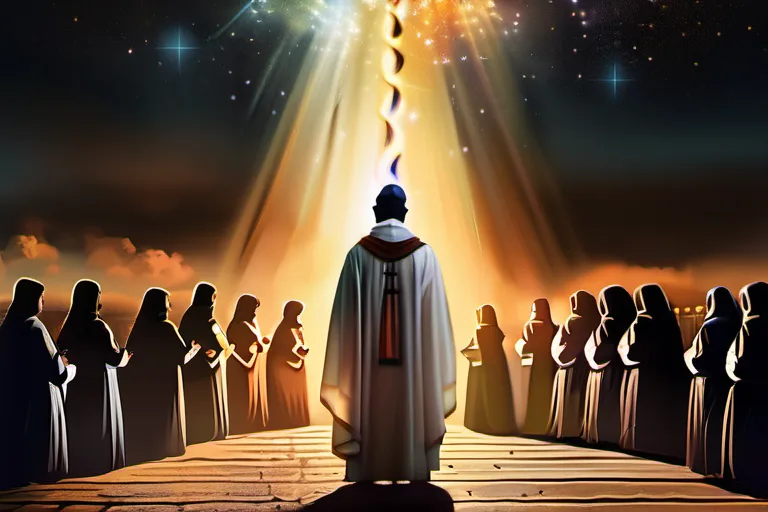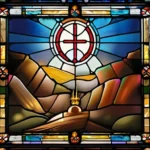Exploring the evidence, historical accounts, and scientific perspectives on religious miracles
Religious miracles have been a part of human history for thousands of years. They are often considered as divine interventions or extraordinary events that defy natural laws. However, the question remains: how do we know these miracles actually happened? In this article, we will delve into the various ways we can verify and understand religious miracles.
The Definition of Religious Miracles
How do we define religious miracles? It’s like trying to catch water in your hands; the moment you think you’ve got it, it slips through your fingers. Religious miracles are those extraordinary events that go beyond natural explanations and are often seen as divine interventions or signs from a higher power.
But why is defining these miracles so challenging? Is it because they defy our understanding of the world, much like trying to grasp a shimmering mirage on a scorching desert day? Each religion has its own set of definitions and beliefs about what constitutes a miracle. For instance, in Christianity, the Transfiguration is seen as a miraculous event where Jesus’ face shone with divine light, while Muslims might point to the splitting of the moon as a significant miracle during the Prophet Muhammad’s lifetime.
The challenge lies not just in pinpointing what constitutes a miracle, but also in verifying their authenticity. Just like trying to prove that a magician’s tricks are real without seeing them performed under controlled conditions, proving the existence of religious miracles is often fraught with skepticism and doubt. How do we know if these events truly happened? Can they be witnessed by everyone equally, or are they shrouded in the subjective experiences of individuals?
One might argue that historical accounts and testimonies play a crucial role. Yet, even here, the reliability of sources can vary widely. Are these stories recorded in sacred texts or passed down through oral traditions? How do we differentiate between fact and fiction when so much of religious history is steeped in myth?
Delving into this question leads us to explore the intricate web of faith, history, and human experience. Whether a miracle truly happened or not may depend on one’s belief system, much like how one interprets the meaning behind a dream or a symbol.
Historical Accounts of Religious Miracles
Have you ever wondered how we can trust stories about miracles from ancient times? After all, these tales often come wrapped in layers of history, culture, and religious belief. How do we sift through it all to understand if a miracle really happened?
Historical accounts of religious miracles are like peeling back the layers of an onion—each layer reveals something new but also adds complexity. Let’s dive into how these stories came about, their reliability, and why they mattered in the context of their time.
Imagine you’re standing at a crossroads, where old beliefs meet modern scrutiny. How do we approach these historical accounts without prejudice? One way is by looking at the context in which these miracles were recorded. Were they written during times of persecution or enlightenment? Were there political or religious motivations behind them?
The reliability of these accounts can be tricky. Just because a story was told doesn’t mean it’s true, right? It’s like trying to verify a rumor—some sources might be more credible than others. Scholars often look at the authorship, date, and content of historical texts to gauge their authenticity.
But why did these stories matter in the first place? Miracles weren’t just about wonder; they were powerful tools for evangelism and community building. Think about it—miracles could provide a sense of divine intervention, explaining natural phenomena or providing comfort during hard times. They acted as a bridge between the sacred and the secular.
So, when we delve into these historical accounts, we’re not just looking at stories; we’re exploring how faith intersects with human experience. These tales might challenge us to question our own beliefs and consider multiple perspectives. In doing so, we can gain a deeper understanding of why miracles matter in religious history.
Remember, every story has its side, and sometimes the truth lies not in one version but in the layers of complexity it presents. As we continue our journey through this guide, remember to keep an open mind and a critical eye as you explore these fascinating accounts.
Scientific Perspectives on Religious Miracles
How do we know religious miracles actually happened? A comprehensive guide delves into scientific perspectives, exploring natural phenomena, hoaxes, and perception to uncover the truth behind these enigmatic events.
Let’s start by pondering a rhetorical question: Can a miracle be explained away as nature simply doing its thing? Consider the phenomenon of healings. Are they due to divine intervention, or could it be that certain conditions make people believe in miraculous cures more than others? For instance, psychological factors can play a significant role. The placebo effect is a well-documented case where patients improve not because of any actual medical treatment but because of their belief in its efficacy.
Then there’s the intriguing aspect of hoaxes and frauds. Throughout history, many so-called miracles have been revealed as elaborate deceptions. Take, for example, the Piltdown Man forgery—a hoax that fooled scientists for decades. This raises a critical question: How can we distinguish between genuine miracles and deliberate tricks? The line between reality and illusion is often blurred, making it challenging to determine which experiences are truly miraculous.
Perception also plays a pivotal role in our understanding of religious miracles. Miracles are not just events; they are experiences that shape belief. Take the case of the Black Madonna at Rue du Bac in Paris, where many believe the statue has healing powers. How do we explain such widespread belief? Is it due to cultural or psychological factors? Perceptions can be deeply influenced by personal experiences, societal norms, and emotional states, all of which affect how people interpret and react to these events.
So, when we ask if religious miracles actually happened, we must consider a wide array of scientific explanations. Natural phenomena, human deception, and the power of perception all contribute to our understanding. Each factor offers a lens through which we can explore the reality behind these extraordinary claims. By examining these aspects, we gain a more nuanced view of what constitutes a miracle in both religious and secular contexts.
Understanding the scientific perspectives on religious miracles helps us navigate the complex landscape of belief and disbelief, ensuring that our inquiries are grounded in a balanced and informed approach. After all, it’s not just about believing; it’s about understanding why we believe or do not believe in these extraordinary events.
Cultural Interpretations of Religious Miracles
When we delve into cultural interpretations of religious miracles, we find ourselves exploring a vast tapestry woven from threads of belief and societal fabric. Miracles, in this context, serve as powerful tools that reinforce faith and shape the very essence of religious communities. How do these narratives gain such traction within societies? Why are they so deeply ingrained?
Imagine a community on the brink of division; then, a wonderful event occurs—perhaps a healing or a sudden transformation—that unites them in awe and reverence. Miracles act as a bridge between the divine and human experiences, making abstract beliefs tangible and relatable.
-
Miracles often serve as testimonials of divine favor or intervention, providing believers with a sense of comfort and security during times of uncertainty. They become icons in the cultural landscape, symbols that transcend the mundane and point towards something greater.
-
The power of these stories lies not only in their immediate impact but also in how they are passed down through generations. Historical accounts, often intertwined with oral traditions, ensure that miracles continue to shape cultural identities and moral codes, creating a sense of continuity and shared history.
Moreover, the interpretation of miracles can vary greatly depending on the cultural context. What one society might see as a divine sign could be viewed skeptically or even dismissed in another. This highlights how deeply intertwined religious beliefs are with broader societal structures and values.
Understanding these cultural interpretations is crucial for grasping why miracles hold such significance in religious contexts. They are more than just singular events; they are multifaceted phenomena that weave through the fabric of society, shaping its narratives, norms, and collective consciousness.
Modern Approaches to Verifying Religious Miracles
How do we know religious miracles actually happened? In today’s world, where technology and scientific methods have advanced significantly, it’s fascinating to explore modern approaches to verifying these ancient accounts. Archaeology, for instance, can be seen as a detective story with clues scattered across the earth. Imagine unearthing a piece of pottery that could confirm an event described in a religious text; it would be like finding the missing puzzle piece to an old mystery.
Forensic science steps into this field by providing tools and techniques to analyze evidence more accurately. It’s akin to using a microscope to see the tiniest details that might have been overlooked in the past. For example, DNA testing on remains can help authenticate stories about figures mentioned in religious texts. This scientific approach not only adds credibility but also enriches our understanding of historical events.
The role of technology in this verification process is transforming how we view and study miracles. Virtual reality, for instance, allows us to experience ancient sites as they might have been back then, providing a vivid backdrop against which miracle stories can be contextualized. Moreover, digital databases and information retrieval systems make it easier to cross-reference sources from different cultures and time periods.
By combining these modern approaches with traditional historical research, we can approach the question of religious miracles more objectively. It’s like weaving together threads from different fabrics to create a rich tapestry that gives us a fuller picture of what might have transpired in the past. Each piece of evidence, no matter how small or seemingly insignificant, contributes to the larger narrative.
The Role of Faith in Understanding Religious Miracles
The role of faith in understanding religious miracles cannot be overstated. How do we reconcile the miraculous claims within our personal beliefs and societal norms? Faith often acts as a bridge, connecting us to a realm beyond everyday experience. Is it possible that faith is merely a subjective journey or does it hold a deeper, objective truth?
Consider the story of St. Anthony’s miraculous bread. Legend has it that when supplies were running low during his time in the Egyptian desert, the bread miraculously multiplied to feed all the monks. This event challenges us to question what we see as impossible and invites us to explore the power of faith.
In societies where faith is deeply ingrained, miracles are often seen as tangible proofs of divine intervention. However, for those who place more trust in empirical evidence, these claims can be met with skepticism. The question then arises: how do we balance our faith with the rational side of our nature?
Is faith a crutch or a guiding light? Many argue that faith provides comfort and meaning to individuals struggling with existential questions. But is it merely an emotional response, or can it inspire profound changes in behavior and society? The impact of religious miracles on community morale and unity cannot be ignored.
The interplay between faith and understanding religious miracles is a delicate dance. It requires us to embrace both the rationality of evidence-based verification and the depth of spiritual experience. Can we find common ground where faith and reason coexist?
In this exploration, we must also consider the role of societal norms. How do cultural and historical contexts influence our perception of miracles? Are certain miracles more accepted in one society than another due to pre-existing beliefs or values?
The journey to understanding religious miracles is complex. It involves a nuanced blend of personal faith, societal norms, and empirical evidence. How can we approach this topic with an open mind while maintaining critical thinking?
Conclusion
 After exploring the different perspectives on religious miracles, it is clear that there is no definitive proof or disproof of their occurrence. However, understanding the historical, cultural, and scientific contexts in which they are reported can help us make informed judgments about their authenticity.
After exploring the different perspectives on religious miracles, it is clear that there is no definitive proof or disproof of their occurrence. However, understanding the historical, cultural, and scientific contexts in which they are reported can help us make informed judgments about their authenticity.











